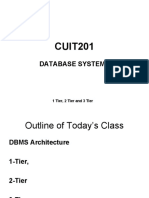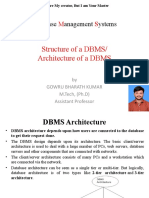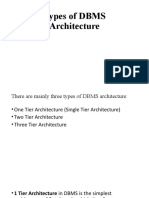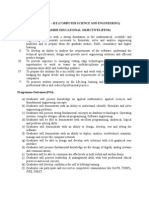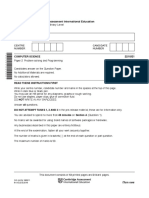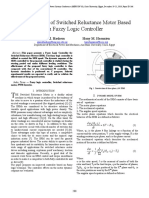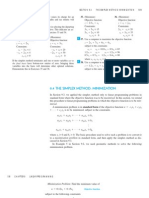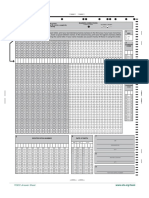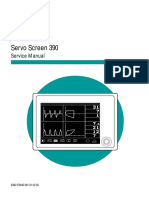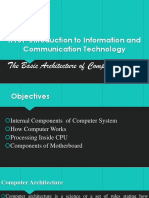DBMS Architecture 1-level, 2-Level, 3-Level
A database stores important information that needs to be accessed quickly and
securely. Choosing the right DBMS architecture is essential for organizing, managing,
and maintaining the data efficiently. It defines how users interact with the database
to read, write, or update information.
DBMS architectures vary according to how users (clients) connect to the database
servers to carry out their requests. Database management systems (DBMS) can be
categorized as single-tier, two-tier, or multi-tier.
Types of DBMS Architecture
There are several types of DBMS Architecture that we use according to the usage
requirements.
1-Tier Architecture
2-Tier Architecture
3-Tier Architecture
1-Tier Architecture
The one-tier Architecture is the simplest DBMS architecture, in which the client,
server, and database are all on the same machine.
This architecture puts the user directly in contact with the database itself, so the user
can create, modify, or delete data within the database.
Every change made by the client is immediately reflected in the database, and all
processing is carried out on one server. In this way, we can perform the operation
directly on the database and get a quick response.
�One Tier DBMS Architecture is employed whenever:
The data isn’t frequently updated.
Multiple users aren’t accessing the database.
A direct and simple method of modifying or accessing the database is required for
application development.
Advantages of 1-Tier Architecture
Simple Architecture
Cost-Effective
Easy to Implement
Disadvantages of 1-Tier Architecture
Limited to Single User
Poor Security:
No Centralized Control
Hard to Share Data
2-tier Architecture
The concept of a two-tier DBMS architecture is similar to that of a client-server
architecture
Client-side applications establish a connection with the server side to communicate
with the database. This interaction is performed through APIs (Application
Programming Interfaces) such as JDBC (Java Database Connectivity) or ODBC (Open
Database Connectivity).
User interfaces and application programs are executed on the client side. Query
processing and transaction management are handled on the server side
�Advantages of 2-Tier Architecture
It is possible to use it simultaneously by multiple users, thus making it suitable for
use within an organization
Scalable: We can scale the database easily, by adding clients or upgrading hardware
Disadvantages of 2-Tier Architecture
As the number of users increases, the system performance can slow down because
the server gets overloaded with too many requests.
Security Issues: Clients connect directly to the database, which can make the system
more vulnerable to attacks or data leaks.
Tight Coupling: The client and the server are closely linked. If the database changes,
the client application often needs to be updated too.
Difficult Maintenance: Managing updates, fixing bugs, or adding features becomes
harder when the number of users or systems increases.
3-Tier Architecture
The 3-tiered architecture is one of the most frequently used DBMS architectures.
Between the server (Database layer) and client (Presentation layer), an
additional layer known as the Application layer is added to reduce the server’s
query processing burden.
Example: E-commerce Store
User: You visit an online store, search for a product and add it to your
cart.
Processing: The system checks if the product is in stock, calculates the
total price and applies any discounts.
Database: The product details, your cart and order history are stored in
the database for future reference.
�Advantages of 3-Tier Architecture
Enhanced scalability: Now, individual connections need not be made between the
client and server.
Data Integrity: 3-Tier Architecture maintains Data Integrity. Since there is a middle
layer between the client and the server, data corruption can be avoided/removed.
Security: 3-Tier Architecture Improves Security. This type of model prevents direct
interaction of the client with the server thereby reducing access to unauthorized
data.
Disadvantages of 3-Tier Architecture
More Complex
Difficult to Interact:
Slower Response Time
Higher Cost

















